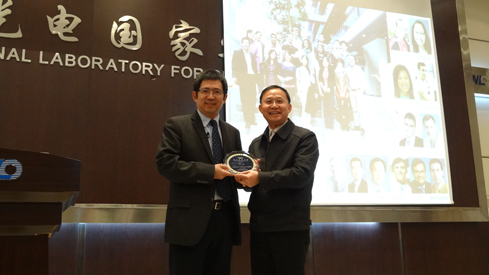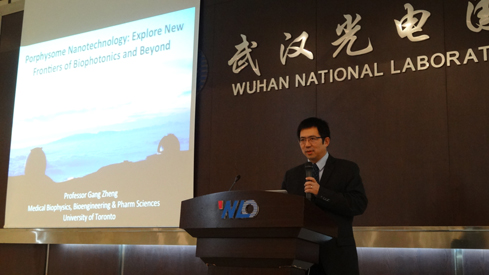WUHAN, China (December 23, 2014) - Wuhan Optoelectronics Forum No. 90 was successfully held in Auditorium A101 at Wuhan National Laboratory for Optoelectronics (WNLO) in the afternoon of December 23.
We recently discovered ‘porphysomes’, the first all-organic nanoparticles with intrinsic multimodal photonic properties. They are self-assembled from porphyrin-lipid building blocks to form liposome-like bilayer vesicle (~100 nm diameter). The very high porphyrin packing density (>80,000 per particle) results in both ‘super’-absorption and structure-dependent ‘super’-quenching, which, in turn, converts light energy to heat with extremely high efficiency, giving them ideal photothermal and photoacoustic properties. Upon porphysome nanostructure dissociation, fluorescence and photoreactivity of free porphyrins are restored to enable low background fluorescence imaging and activatable photodynamic therapy. In addition, metal ions can be directly incorporated into the porphyrin building blocks of the preformed porphysomes thus unlocking their potential for PET and MRI. By changing the way porphyrin-lipid assembles, we developed porphyrin nanodisc (<20 nm), trimodal (US/photoacoustic/fluorescence) porphyrin shell microbubbles (~2 μm), microscopy-controlled porphyrin protocells (~100 μm), and hybrid porphyrin-gold nanoparticles, expanding the purview of porphyrin nanophotonics. Compared with classical “all-in-one” nanoparticles containing many functional modules, the simple yet “one-for-all” nature of porphysomes represents a novel approach to the design of multifunctional nanoparticle and confers high potential for clinical translation.
Dr. Zheng is a Professor of Medical Biophysics, Biomedical Engineering and Pharmaceutical Sciences at the University of Toronto, a Senior Scientist, the Joey and Toby Tanenbaum/Brazilian Ball Chair in Prostate Cancer Research at the Princess Margaret Cancer Center, and the Scientific Lead for Nanotechnology and Radiochemistry at the Techna Institute. Dr. Zheng received his PhD in 1999 from SUNY Buffalo in Medicinal Chemistry. Following two year postdoctoral training in photodynamic therapy at the Roswell Park Cancer Institute, he joined the University of Pennsylvania in 2001 as an Assistant Professor of Radiology, where he established the molecular imaging chemistry program and introduced photodynamic molecular beacons and lipoprotein-like nanoparticles. Since moving to Canada in 2006, his research has been focused on developing clinically translatable technology platform to combat cancer. His lab recently discovered porphysome nanotechnology that opens a new frontier in cancer imaging and therapy, which was named one of the “top 10 cancer breakthroughs of 2011” by the Canadian Cancer Society. He currently serves as the PI for 10 research grants (total $15 million). Since 2014, Dr. Zheng serves as the Chair for the Molecular Probes and Nanobio-Optics Technical Group, the OSA and as an Associate Editor for the Bioconjugate Chemistry.

